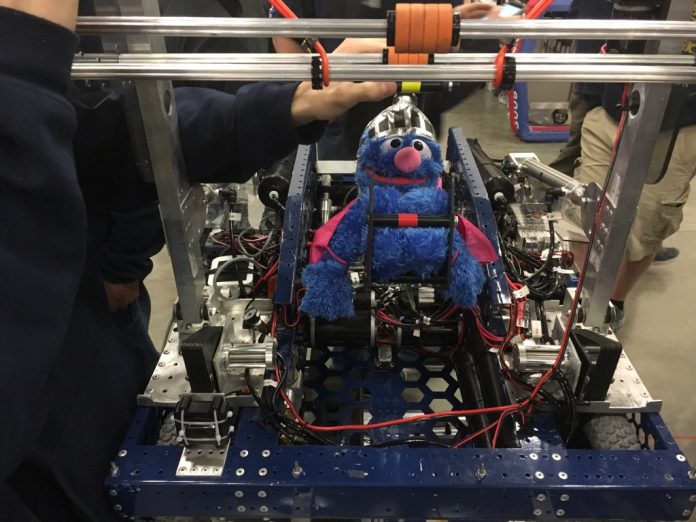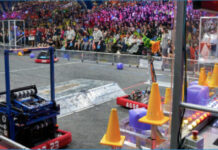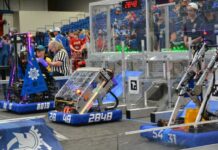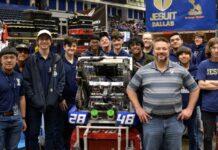On the smooth green surface of the ground, a rectangular contraption, made of metal and wooden beams, scurries across the arena. Various wires cover the automated machine, connecting into electrical ports, sending data and information that help it operate. The robot first extends out an arm, clenching onto a small five-inch white whiffle ball. Slingshotting this arm forward, it flings the ball through the air towards an illuminated goal. Then, it quickly rolls over to a bordering wall, grabbing a 12-inch gear and securing it to the hull. Rapidly, it shoots across the field towards the opposite wall and hangs the gear from a protruding wooden peg. Finally, it moves towards the center and sits beneath a tall-standing metal structure with various ropes hanging from it. With a firm grip, it clings onto one of these ropes and hoists itself up, the various gears and motors churning as it ascends. At the very top, the robot stares at a glaring red button and punches it in, finishing its third and final task.
From March 8th to the 11th, Jesuit’s FIRST Robotics Competition team 2848 participated in the Dallas Regional at the Irving Convention Center. 50 teams from two states and three countries gathered for this competition, which featured practice matches, qualification matches and final rounds which determined victors of the tournament.
In these games, the robots were tasked with three objectives: moving gears across the arena and placing them on small pegs, shooting whiffle balls through a designated goal on the wall and lifting themselves up a rope to a platform where they push in a button. Each task awards the robotics team points which contribute to their score.
In these events, different teams not only compete against each other in the arena, but they also work together in arrangements known as alliances. Each match consists of three robots against three others, and during the qualification matches, alliances are random. After these preliminary events, each team is given a rank determined by their score and how their robot performed. The captains of alliances 1-8 then pick teams to join their alliance, and this group goes onto the playoffs.
Jesuit was ranked #4, but the #1 ranked team merged them into an alliance. Overall, Jesuit and its group, which included Cistercian, lost in the second round of the playoffs, earning them a semifinalist position. After the conclusion of the tournament, many members of the team explained the preparation it takes to compete in these competitions and offered a reflection on their results.
To succeed in robotics, the team has to work diligently to construct and perfect a working robot. Commenting on this, Will Curran ’17 stated, “As build season ended, the programmers and electrical team ramped up their efforts and worked around the clock to work on our autonomous mode. We made several tweaks, specifically changing how the robot’s brain uses data sent to it by an android phone for computer vision.”
Even as the competition was nearing, the group was still hard at work, making major and minor changes to assemble the most efficient machine possible. Reflecting this experience as well as expounding on the human aspect of robotics, Jack Barone ’18 shared, “We knew we had to get our Autons (autonomous mode) to work perfectly, so the programming team spent a lot of time tuning it in. Also, the drive team practiced a lot prior to the regional, so we built chemistry and were able to perform at a high level.” Not only does the robot need to perform in peak condition, but the team needs to practice working with the robot through each individual task assigned to them, exactly like various other sports at Jesuit.
Harrison Pope ’18 detailed these trial runs, explaining that “we worked on reducing the time that we pick up gears… We had about an hour or two of driver practice every other day after school and played against tough defense so we would be prepared.” Striving for success, the team works for hours after school, running through the motions and fine-tuning their skills.
These skills allow the team to compete in tournaments and help them achieve the results they desire. After this competition, many of the students shared their thoughts on their performance. Praising the team’s efforts, Curran stated, “I was very pleased with how we performed because of all the hard work we put in beforehand. When things didn’t work smoothly, we were able to calmly adjust things on the fly, but our drivers did an excellent job in the end.” In his reflection, Will focuses on what the team did well rather than the results they earned.
Others, however, were dissatisfied with their subordinate placing. “We did not get the results we desired after ending in the semifinals with a close score,” said Jacob Dewa ’18. Despite not placing first place, junior Harrison Pope explained how it motivated the team to refine and sharpen their efforts: “We were all disappointed in the result. However, we knew exactly what we needed to improve on after that..as soon as the competition ended, we went back to work with practice and new strategies.”
Ultimately though, when it comes down to sports, results are almost always not the most important aspect, and for Mr. Couvillon, head coach of the robotics team, his favorite part of the experience or the part that holds the most significance is “seeing the development and maturity of students over the years.” Like Baseball or Basketball or Soccer, in robotics, the coach not only improves every player’s skills and guides them as a team, but he also fosters their growth into the men for others that Jesuit sets out to implant in each student.
Overall, the team prepared thoroughly and worked together to produce an efficient robot that would compete in this tournament and the many tournaments to come. Despite earning semifinalist, just short of their aspiration for first place, they were not dismayed and used their shortcoming as encouragement for the next tournament.






